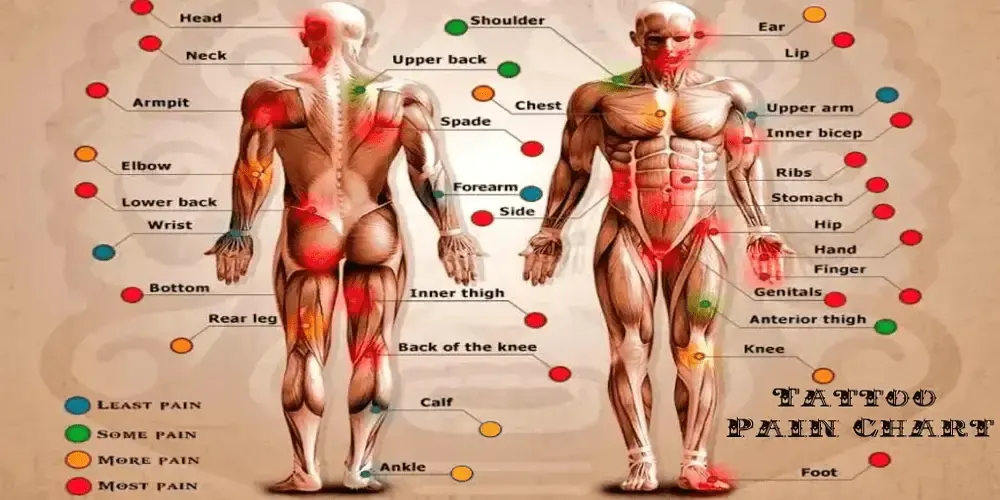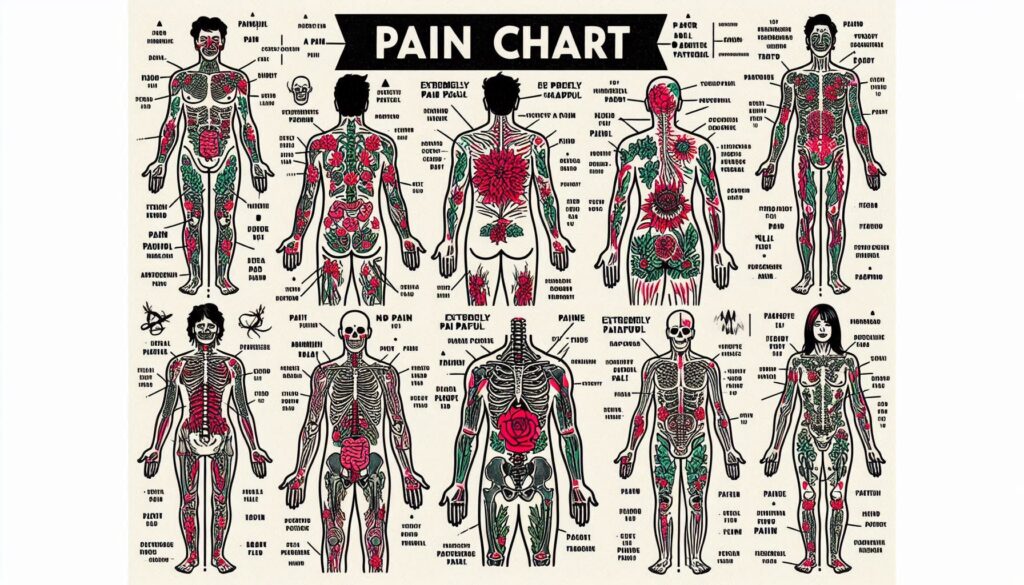Tattoo Pain Chart: What to Expect When Getting Inked in Australia
Tattoos have woven themselves into the fabric of modern Australian culture, with more people than ever opting to permanently ink their bodies. But before you take the plunge and get that design you’ve been dreaming about, it’s essential to understand one key aspect of the tattoo experience: pain.
The pain associated with getting a tattoo varies widely depending on various factors, including the tattoo’s placement, size, and your personal pain threshold. This guide will help you navigate what to expect when it comes to tattoo pain, with insights tailored to the Australian context.

Understanding Tattoo Pain
Tattoo pain is a multifaceted experience, shaped by several factors. Here’s a quick overview:
- Tattoo Needle Sensation: A tattoo needle creates a sensation that’s often described as a combination of scratching, burning, and vibrating. The pain is generally localized to the area where the needle is working.
- Pain Threshold: Each person’s pain threshold is different. Some people may find the process more uncomfortable than others, depending on their personal pain tolerance.
- Tattoo Size and Complexity: Larger and more detailed tattoos tend to cause more discomfort than smaller, simpler designs. This is due to the increased amount of time the needle is in contact with your skin.
- Tattoo Placement: Certain areas of the body are more sensitive than others. Generally, areas with less flesh and more nerve endings will be more painful.
Tattoo Pain Chart: What to Expect by Body Area
Understanding how different body areas respond to tattooing can help you mentally prepare for the experience. Here’s a breakdown of common tattoo locations and the associated pain levels:
1. Outer Arm
The outer arm is one of the least painful areas to get tattooed. The skin here is relatively thick and has fewer nerve endings compared to other parts of the body.
- Pain Level: Low to Moderate
- Details: The outer arm offers a more tolerable experience for most people, making it a popular choice for first-time tattoo recipients.
2. Inner Arm
The inner arm is significantly more sensitive due to the thinner skin and higher concentration of nerve endings.
- Pain Level: Moderate to High
- Details: Tattooing the inner arm can be quite uncomfortable, especially near the elbow or armpit. This area is more prone to irritation, which can make the process feel more intense.
3. Ribcage
Tattooing the ribcage is notorious for being one of the more painful areas. The skin here is thin, and there’s minimal flesh covering the bones.
- Pain Level: High
- Details: The proximity to the ribs and the continuous vibration of the needle can make this area quite painful. It’s advisable to be prepared for significant discomfort if you choose this location.
4. Spine
The spine area, especially along the vertebrae, can be particularly sensitive. The skin is thin, and the needle’s vibrations can resonate through the bones.
- Pain Level: High
- Details: The pain can be intense, particularly along the lower back and near the shoulder blades. It’s a good idea to have a high pain threshold if you’re considering a spine tattoo.
5. Feet and Ankles
The feet and ankles are also quite sensitive due to the proximity to bone and a high density of nerve endings.

- Pain Level: High
- Details: The pain can be sharp and intense, especially around the bony areas. The skin on the feet is also relatively thin, which adds to the discomfort.
6. Hands and Fingers
Getting tattooed on the hands or fingers can be very painful due to the thin skin and the high concentration of nerve endings.
- Pain Level: High
- Details: This area tends to be one of the most painful spots, with the sensation often described as sharp and intense. Additionally, healing can be challenging due to frequent movement and exposure.
7. Thighs
The thighs are a relatively more comfortable area to get tattooed, given the thicker skin and flesh.
- Pain Level: Low to Moderate
- Details: The inner thigh can be more sensitive than the outer thigh, but overall, this area offers a more tolerable experience compared to others.
Factors Affecting Tattoo Pain
Several factors can influence how much pain you experience during a tattoo session. Here’s a closer look at these factors:
1. Tattoo Size and Complexity
Larger and more intricate tattoos require longer sessions and more needlework, which can increase the level of discomfort. The longer the session, the more fatigue and sensitivity you may experience.
2. Tattoo Artist’s Technique
The skill and technique of your tattoo artist can affect how much pain you feel. Experienced artists use techniques that minimize discomfort and ensure a smoother process.
3. Personal Pain Tolerance
Everyone’s pain threshold is different. While some people might find getting tattooed to be only mildly uncomfortable, others may experience more intense pain.
4. Body Location and Skin Type
As discussed earlier, some areas of the body are naturally more sensitive. Additionally, individual factors such as skin type and body composition can also play a role in how pain is perceived.
Tips for Managing Tattoo Pain
If you’re concerned about the discomfort associated with getting a tattoo, there are several strategies you can use to make the experience more manageable:
1. Choose a Reputable Tattoo Studio
Selecting a high-quality tattoo studio with experienced artists can make a significant difference. Professionals will have techniques and equipment that minimize discomfort and ensure a more efficient process.

2. Stay Hydrated and Well-Nourished
Being well-hydrated and nourished before your tattoo session can help your body cope with the stress of tattooing. Avoid drinking alcohol the night before, as it can increase sensitivity.
3. Communicate with Your Artist
Let your tattoo artist know if you’re feeling uncomfortable. They can take breaks or adjust their technique to help manage your pain levels.
4. Use Numbing Creams
Topical numbing creams can be applied before your tattoo session to reduce pain. However, always consult with your tattoo artist before using any numbing products to ensure they’re suitable for your tattoo.
5. Practice Deep Breathing
Deep breathing techniques can help manage pain and reduce anxiety during your tattoo session. Focus on slow, deep breaths to keep yourself calm and centered.
6. Bring Distractions
Bringing something to distract yourself, such as music or a book, can help take your mind off the discomfort. Engaging in conversation with your tattoo artist can also be a helpful distraction.
Aftercare for a Comfortable Healing Process
Proper aftercare is crucial for a smooth healing process and minimizing any discomfort during recovery. Here are some tips:
- Follow Aftercare Instructions: Adhere to the aftercare instructions provided by your tattoo artist. This typically includes keeping the tattoo clean, moisturized, and protected from the sun.
- Avoid Scratching or Picking: As your tattoo heals, avoid scratching or picking at it. This can cause irritation and affect the final appearance of your tattoo.
- Stay Cool and Comfortable: Avoid hot showers and saunas, as excessive heat can irritate the tattooed area. Opt for cool, gentle showers instead.
Conclusion
Understanding what to expect in terms of pain when getting a tattoo can help you mentally prepare for the experience. While certain areas of the body may be more sensitive than others, many people find the discomfort to be manageable with the right preparation and mindset.
For expert advice on getting your next tattoo in Australia, including pain management tips and aftercare guidance, visit Tattoos Down Under. Embrace your tattoo journey with confidence and enjoy the art that will be a part of you forever.


Leave a Reply